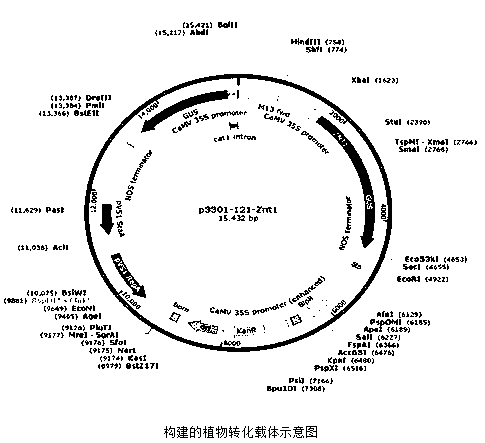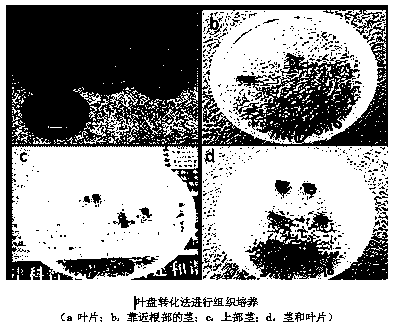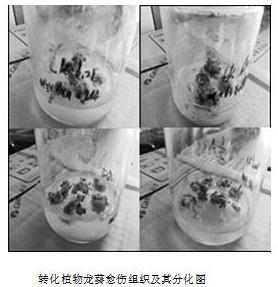Plant repair method of applying transgenetic plant composite system to polluted soil
A technology of transgenic plants and polluted soil, applied in the field of heavy metal remediation, to achieve the effect of improving absorption and accumulation capacity, strong adaptability and strong resistance
- Summary
- Abstract
- Description
- Claims
- Application Information
AI Technical Summary
Problems solved by technology
Method used
Image
Examples
Embodiment 1
[0066] Construction of transformation vectors and transformation of plants:
[0067] 1. Construction of transformation vector:
[0068] The Znt1 gene (derived from the Brassica cerevisiae ( Thlaspi caerulescens ) Znt1 gene, which was retrieved by the applicant on GenBank and obtained Celestia chinensis ( Thlaspi caerulescens ) of the Znt1 cds sequence, which was obtained by chemically synthesizing the Znt1 target gene fragment by Nanjing Yidao Biotechnology Co., Ltd., and then amplified by PCR), digested with restriction endonucleases SmaⅠ and XbaⅠ, and then ligated to The latter plasmid expression vector is the plant transformation vector p3301-121, and named as p3301-121-Znt1 plasmid (see its structure figure 1 ), transformed into Agrobacterium strain EHA105 by freeze-thaw method;
[0069] 2. Plant genetic transformation:
[0070] The Agrobacterium with p3301-121-Znt1 plasmid cultivated overnight was centrifuged, and the bacteria were suspended in liquid MS 1 / 10 medium...
Embodiment 2
[0072] Resistance of transgenic plants to heavy metals lead and cadmium:
[0073] Material selection and experimental procedures: select the leaves of the transgenic Solanum nigrum line with positive PCR as the material, and multiply the selected leaves by the method of plant tissue culture, and antibiotics (50mg / L Kan+250mg / L Kan+250mg / L Rif ) to screen, when the regenerated plant has 5-6 leaves, select the plant with the same size, remove the root and transfer it to the rooting medium containing different cadmium and lead ion concentrations for growth observation. CdSO 4 (10mg / ml ), PbCl 2 (10mg / ml) solution, so that the cadmium ion concentration in the medium is divided into five levels (0, 50, 100,150, 200 µmol / L), and the lead ion concentration is divided into five levels (0, 25, 50, 75, 100 μmol / L), each level was repeated three times, 28°C, 16h light culture, one month later, the stems, leaves and roots were harvested and washed with distilled water, and then the ha...
Embodiment 3
[0075] Accumulation effect of transformed Solanum nigrum on heavy metals under different substrate conditions:
[0076] Soil culture: Transplant p3301-121-Znt1 gene Solanum nigrum and wild-type Solanum nigrum into flowerpots equipped with 500g soil to cultivate and grow for about one month, during which time MS nutrient solution is used to pour once a week, and after one month, start to CdSO with different concentrations of heavy metals added to the soil 4 (10mg / ml) and PbCl 2 (10mg / ml) solution, where Cd 2+ The concentration is divided into five levels (0, 80, 160, 240, 320µmol / L), Pb 2+ Concentrations were divided into five levels (( 0, 50, 100, 150, 200µmol / L ), and each level was repeated three times. Solanum nigrum was cultivated and grown for one month, and the aboveground stems, leaves and roots were harvested separately, washed with distilled water, and then Dry it at 80°C and pulverize it for testing. The analysis of heavy metal content in Solanum nigrum tissue is ...
PUM
| Property | Measurement | Unit |
|---|---|---|
| Depth | aaaaa | aaaaa |
| Adsorption | aaaaa | aaaaa |
Abstract
Description
Claims
Application Information
 Login to View More
Login to View More - R&D
- Intellectual Property
- Life Sciences
- Materials
- Tech Scout
- Unparalleled Data Quality
- Higher Quality Content
- 60% Fewer Hallucinations
Browse by: Latest US Patents, China's latest patents, Technical Efficacy Thesaurus, Application Domain, Technology Topic, Popular Technical Reports.
© 2025 PatSnap. All rights reserved.Legal|Privacy policy|Modern Slavery Act Transparency Statement|Sitemap|About US| Contact US: help@patsnap.com



